Location: Weatherford, OK
Challenge
- Inadequate water supply, heat and moisture stress and weeds pose significant production challenges.
Farm Goals
- Increase yield and cotton fiber quality
Trial Setup
- A split-field design was used to compare UpTerra-treated cotton and untreated cotton for agronomic performance. Control and treatment acres had similar topography and soil types.
- TerraFlow® devices were installed directly in the irrigation system to enhance water use across the treated side of the field. The units use a patented process that organizes and enhances irrigation water via simultaneous vortexing and frequency transmission, aimed at improving soil infiltration and plant hydration.
- TerraNet® frequency transmitters were deployed to deliver targeted signals designed to support soil and plant health. These frequencies, transmitted via the irrigation system, were intended to stimulate biological processes such as nutrient uptake, microbial activity and plant resilience throughout the growing season.
- Fertilizer rates, planting populations and dates, irrigation schedules and harvest dates remained consistent between control and treatment fields.
- Throughout the growing season, eleven different measurements were taken on five plants at each of the five locations in both the treated and control areas of the field on a bi-weekly basis to monitor and track physiological differences between the treatment and control.
- Soil health assessments were conducted at five distinct locations, accounting for soil variability. The measured parameters included infiltration time, soil aggregation, compaction and physical observations.
- Soil moisture sensors were installed at various depths to monitor moisture availability in the control and treated sides of the field. Seasonal moisture data was analyzed to evaluate plant and soil responses to different water conditions, including comparing the percentage of available moisture at each depth.
- Each side of the field was harvested separately, with gin tickets and machine data used to compare the yields.
- Statistical analyses were conducted on all applicable data, including a paired T-test and Least Significant Difference analysis.
Trial Results
The following results were observed in the UpTerra-treated field, relative to the control.
- 10.54% yield increase according to gin data
- 0.0137 lower loan rate due to fiber quality*
- Faster water infiltration rate in the soil
- Enhanced soil aggregation
- Aggressive water uptake in the top profile, deeper root activity, better retention and improved moisture availability in shallow depths
- Higher moisture reserves at deeper soil depths (30″–34″), better protection against late-season water stress
Yield Results
Pounds Per Acre+75.85 change |
Fiber Institute Sample Yield Estimate
Lint and seed were separated from equal sample weights from the samples sent to the Fiber and Bipolymer Research Institute at Texas Tech University. The analyzed results are summarized below.
| Seed Cotton Net Weight (g) | Fiber Weight (g) | Fiber Percentage (%) | |
| UpTerra-Treated | 9520 ↑ | 3780 ↑ | 39.71 ↓ |
| Control | 9300 | 3770 | 40.54 |
Fiber Quality Metrics
Fiber quality metrics were recorded based on analyses by the Fiber and Bipolymer Research Institute and at the gin.
| Fiber Institute Quality Metrics | |||
| Treated | Control | Percent Difference | |
| Leaf | 3.0 | 4.0 | ↓ -25.00% |
| Strength | 32.10 | 31.80 | ↑ 0.94% |
| Micronaire | 3.29 | 3.59 | ↓ -8.36% |
| Length (1/100s inch) | 1.167 | 1.171 | ↓ -0.34% |
| Reflectance | 70.80 | 72.50 | ↓ -2.34% |
| Yellowness | 8.20 | 8.10 | ↑ 1.23% |
| Uniformity | 81.40 | 81.40 | 0.00% |
| Elongation | 6.30 | 6.30 | 0.00% |
| Gin Quality Metrics | |||
| Treated | Control | Percent Difference | |
| Color | 41.91 | 41.67 | ↑ 0.57% |
| Leaf | 3.04 | 3.13 | ↓ -2.78% |
| Staple | 36.93 | 31.33 | ↓ –1.05% |
| Micronaire | 35.89 | 34.87 | ↑ 2.93% |
| Strength | 33.14 | 33.08 | ↑ 0.18% |
| Uniformity | 80.82 | 80.91 | ↓ –0.12% |
Soil Health Assessment
Soil health assessments were conducted at five distinct locations, accounting for soil variability. The measured parameters give insight into soil health characteristics.
Infiltration Time
- Treated Soil: Average infiltration time of 3.8 minutes.
- Control Soil: Average infiltration time of 5.1 minutes.
The treated soil infiltrated water 1 minute and 20 seconds faster than the control, requiring 25.49% less time for water infiltration. This indicates improved soil porosity and permeability in treated soil.
Soil Aggregation
- Treated Soil: Average score of 5.8.
- Control Soil: Average score of 4.0.
The treated soil demonstrated a 45% increase in soil aggregation. Enhanced aggregation suggests better soil structure and stability, which supports plant growth and water retention.
Soil Compaction
- Treated Soil: Average PSI at 4 inches, 8 inches, and 12 inches: 196.53, 303.67, 275.4.
- Control Soil: Average PSI at 4 inches, 8 inches, and 12 inches: 199.93, 322.47, 306.93
The treated soil demonstrated up to 10.27% lower PSI than the control. This data indicates that the treated field has less compaction, which could lend to better soil aggregation, aeration, root penetration and infiltration.
Soil Moisture Assessment
The UpTerra-treated field demonstrated enhanced soil moisture retention and improved infiltration dynamics, contributing to better water availability across key rooting depths.
Mid-depth layers (10”–22”) retained moisture longer, ensuring stable hydration during critical growth stages such as boll development and opening. Enhanced infiltration rates and a stair-step moisture pattern indicate steady water uptake, optimizing the crop’s ability to withstand dry periods and reducing reliance on frequent irrigation.
Conversely, the control field experienced more pronounced moisture fluctuations, with rapid depletion at mid-depths (18”–22”), leading to intermittent water stress. The control soil struggled to hold moisture consistently, requiring more frequent irrigation to sustain crop growth. The deeper soil layers (30”–34”) in both fields remained largely unused, acting as a long-term reserve but demonstrating greater moisture stability in the treated field.
These findings suggest that UpTerra-energized water improved soil moisture efficiency, allowing for better water retention in the plant’s active root zone while reducing evaporation losses. The ability to sustain moisture levels despite drier-than-average conditions from April through September indicates a potential advantage in mitigating water stress risks and enhancing crop resilience under challenging growing conditions.
Agronomy Field Assessments
Throughout the growing season, eleven different measurements were taken on five plants at each of five locations in both the treated and control areas of the field. These measurements were then averaged to represent each location. Observations of the treated cotton plants showed key differences from the untreated plants.
Plant Population and Structural Development
- The treated plants showed a 3.13% higher plant population, which could positively impact overall boll production.
- On average, treated plants were 0.61 inches shorter and had slightly fewer branches, indicating a more compact plant structure.
Fruit Development and Maturity
- The treated plants demonstrated later fruiting but reached earlier maturity, as evidenced by an earlier cutout compared to the control, which could have negative implications for yield.
- 0.16-inch shorter internode lengths were also observed, suggesting that the treatment may have contributed to denser, more compact growth.
- No differences were noted in the overall growth stage between the treated and control plants.
In all, these results suggest that the treatment promoted denser, faster-maturing plants.
Key Trial Takeaways
- The results indicate that TerraFlow has a positive impact on plant health, cotton yield and quality, soil moisture distribution and soil health characteristics.
- Better moisture availability in the soil helped reduce plant stress during drought conditions and could reduce irrigation needs.
- This trial suggests that UpTerra technologies can help cotton growers achieve higher yields and better water management, improving overall profitability potential.
| Agronomic benefit | Economic benefit | Operational benefit |
| Improved yield (lbs/ac) | Higher revenue per acre | Reduced production cost/lb of cotton |
| Improved soil hydration | Higher yield potential, especially during times of water stress; reduced irrigation costs | Better risk mitigation against production challenges; water conservation and improved soil health |
Related Content
Mastering Cotton Irrigation: A Complete Guide
Why Your Crops May Be Struggling: It Might Not Be What You Think
5 Ways to Build Soil Health for Better Plant Nutrient Uptake
* Based on loan rates provided by the gin


